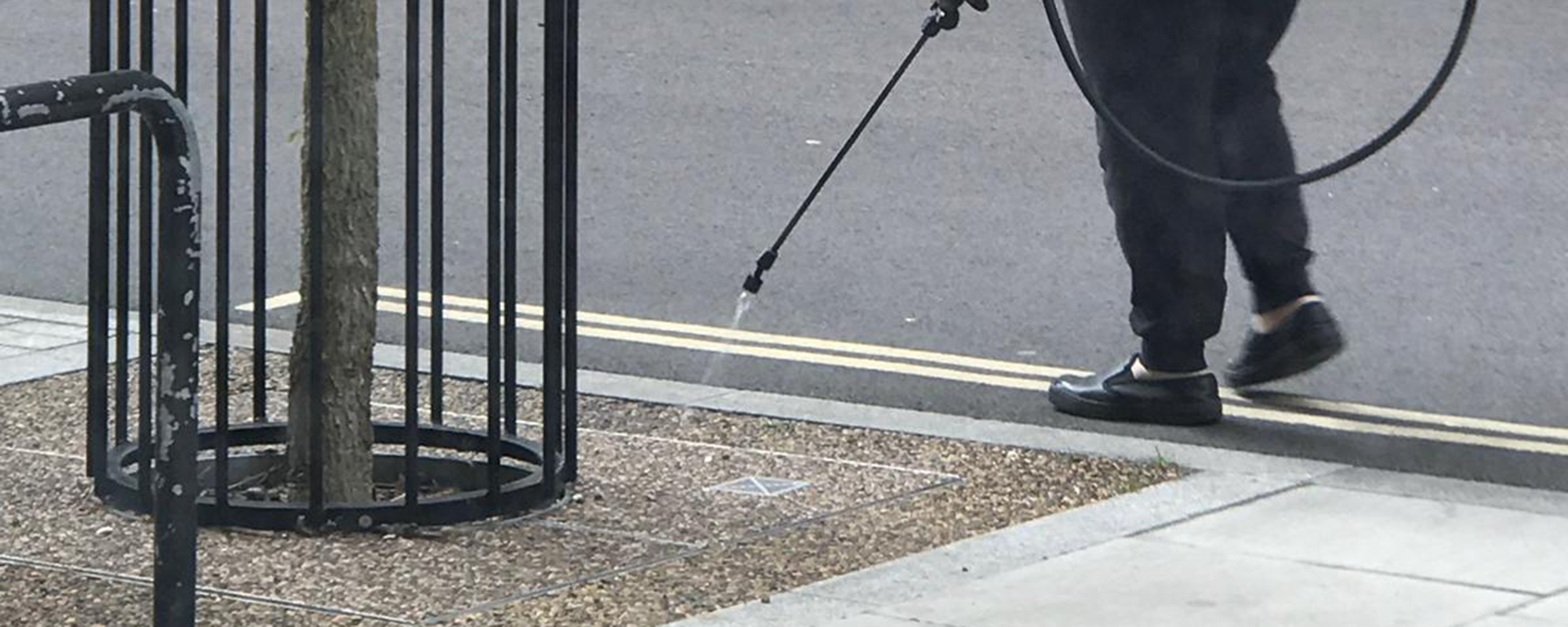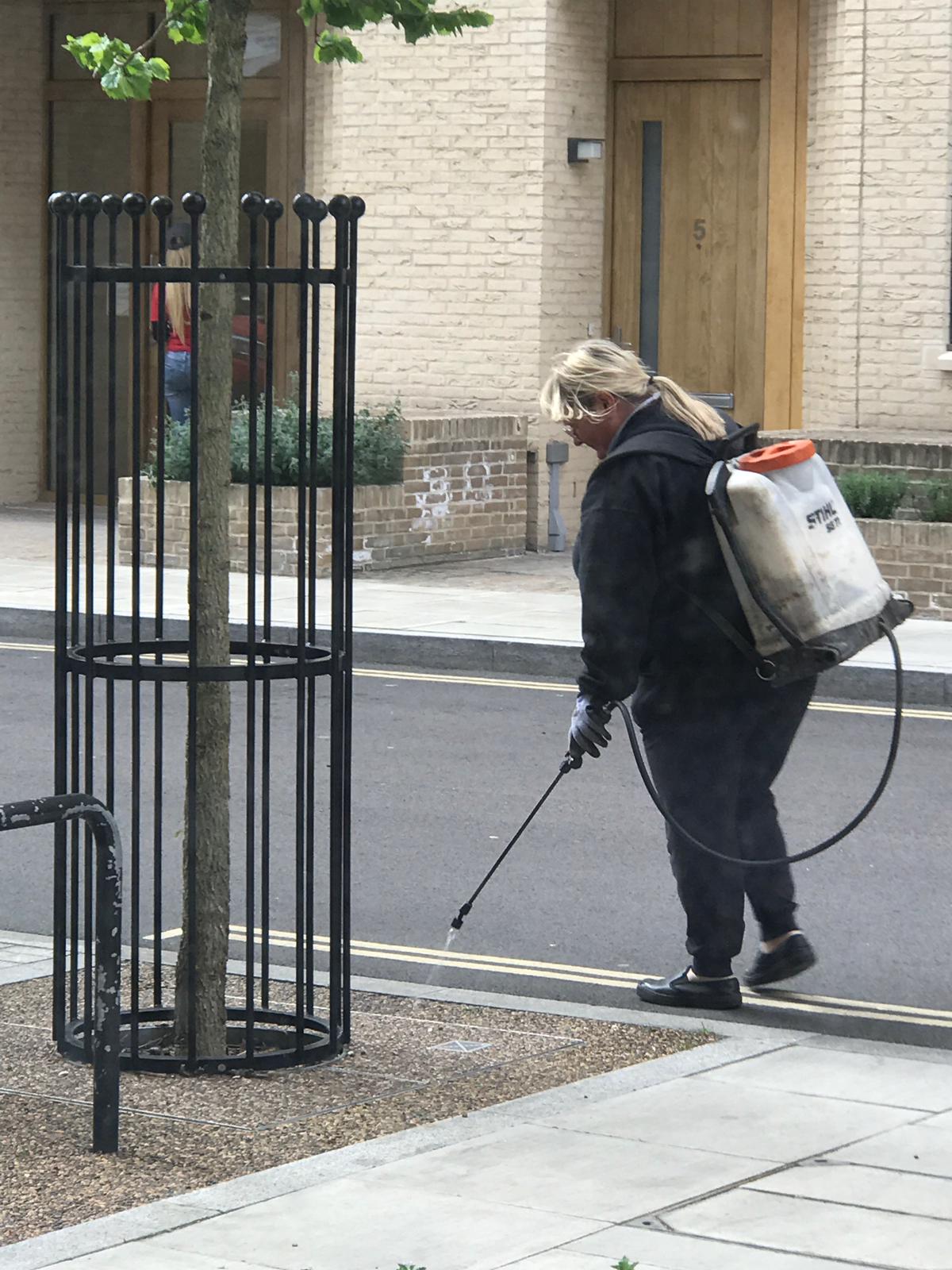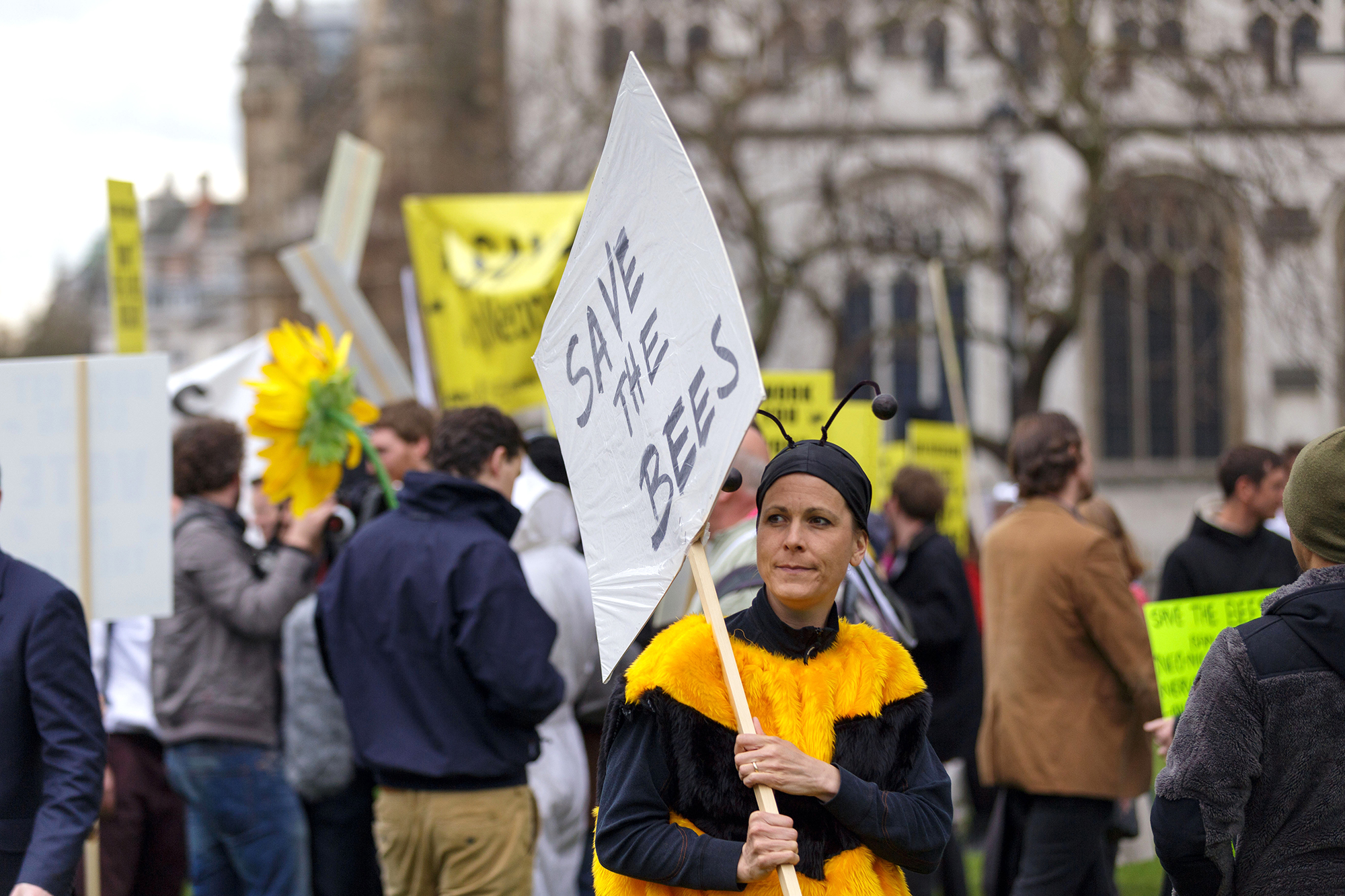Get updates from The Developer straight to your inbox Yes, please!
Exclusive: 98% of councils use weedkiller linked to cancer in public spaces
Investigation reveals widespread exposure to herbicide glyphosate estimated to increase cancer risk by 41% in playgrounds, schools and near homes. Christine Murray reports

An investigation by The Developer has revealed that 98% of councils use weedkillers containing glyphosate in 2018-19, with 97% applying it within 10 metres of private homes, schools, housing estates or playgrounds.
Glyphosate, the active ingredient in Monsanto’s Roundup, is frequently used in towns and cities to stop the growth of plants on hard surfaces such as parking lots, footpaths, highways, fence lines, pavements, paths and brick walls in public urban spaces. It is considered the most-used herbicide in the world.
Researchers from the University of Washington recently estimated that glyphosate exposure increased the cancer risk of non-Hodgkin’s lymphoma by 41%. In 2015, the World Health Organisation’s International Agency for Research on Cancer classified glyphosate as “probably carcinogenic to humans”.
In response to a Freedom of Information Act (FOIA) request, 316 out of 322 councils say they used a glyphosate-based weedkiller in 2018-19, with half having used a Roundup-branded product.
Where councils had responsibility for maintenance, 94% of FOIA responses from local authorities say they have used glyphosate on housing estates (253 out of 270); 69% used glyphosate on playgrounds (198 out of 288); and out of 179 councils, 61% (109) say they have used glyphosate on school grounds.
However, six councils say they do not use glyphosate: Hammersmith & Fulham, Lewes, North East Derbyshire ALMO (Rykneld Homes), Ryedale, Sevenoaks and Southampton. Lewes Council states that it will also be stopping the use of glyphosate in Eastbourne in future as the two councils have combined service provision.
“We have no intention of returning to glyphosate,” says councillor Wesley Harcourt, cabinet member for the environment, Hammersmith & Fulham Council
Other councils say use of the herbicide is under review, with nine councils specifically stating that they are seeking to reduce their use of glyphosate and others are trialling alternative approaches.
The Pesticide Action Network says Brighton, Bristol, Derry and Trafford are adopting policies to significantly reduce and ultimately eliminate pesticide use, while Hackney and Croydon have also committed to reducing glyphosate use.
On 4 July, following the publication of this article in May, the London Assembly adopted a motion calling on all London boroughs to stop using glyphosate on council property. It also called on mayor Sadiq Kahn to initiate a plan to eliminate glyphosate use on the Greater London Authority estate.
In March 2019, a federal jury in the US found that use of the glyphosate-based weedkiller Roundup had been “a substantial factor” in causing the cancer of a California former school groundskeeper in the second high-profile ruling to link Roundup with non-Hodgkin’s lymphoma.
In the wake of the US cases, the Financial Times reported that Bayer, which acquired Roundup manufacturer Monsanto last year for £63bn, faces “an avalanche of legal cases” estimated at around 14,000.
Bayer says its products pose no health risks. “Regulators worldwide continue to conclude, based on independent assessments, that glyphosate-based products can be used safely as directed and that glyphosate is not carcinogenic,” Bayer told The Developer.
Councillor Wesley Harcourt, cabinet member for the environment at Hammersmith & Fulham Council, says: “Hammersmith & Fulham Council stopped the use of glyphosate on streets, estates and parks and open spaces two years ago based on health reasons as per the many reports from Europe and possible lawsuits in the US.”
“We are now using steam and another hot foam method to remove weeds, along with some manual weeding where necessary. We have no intention of returning to glyphosate,” Harcourt adds.
Hackney says it has “significantly” reduced its spraying on highways, although its FOIA response indicates a 66% increase in use on parks and green spaces. Fareham Borough Council has invested in foamstream treatment and weed-ripping machinery, while East Sussex Highways says it is currently looking into alternative methods.
Other councils appear entirely reliant on glyphosate, however, with 118 councils saying they use no alternative herbicides, mechanical or manual methods of weedkilling.
And while 90 councils have decreased their use of glyphosate in 2018-19 and 94 councils say their usage is unchanged, 68 councils say they have increased their use of the herbicide, with some citing the weather or Japanese knotweed as requiring more applications.
69% of local authorities say they used glyphosate on playgrounds and 97% have applied glyphosate to housing estates where responsible for maintenance
Asked to respond to the findings that some councils are moving away from glyphosate use, a spokesperson from Bayer says, “There is no evidence that local councils who choose to move away from glyphosate for amenity weed management are enhancing safety.”
Glyphosate is approved for use in the UK until 2022.
Nick Mole, policy officer for the Pesticide Action Network UK, the charity behind the Pesticide-Free Towns initiative, expressed his alarm that so many councils are using glyphosate, saying: “There is cause for concern.
“Glyphosate has been linked with a number of health issues, not only cancer. It is being sprayed, needlessly, in areas where children, potentially the most vulnerable to its harmful effects, live and play,” Mole says.
“There is a large enough body of evidence for the precautionary principle to be employed – not least because there are effective alternatives available.”
“The current legal cases in the US are only the top of the iceberg” Nick Mole, policy officer for the Pesticide Action Network UK
The biggest spender on glyphosate is Norfolk, which spent £297,432 on glyphosate and its application including labour, followed by Camden Council, which spent £140,653, with Milton Keynes having spent £115,653 and Hackney £106,801 on the herbicide and its application.
The top three biggest users of glyphosate among the 297 local authorities that responded to the FOIA request are Milton Keynes at 11,065 litres, followed by South Tyneside at 9,860L (with 9,400L of this applied by South Tyneside Homes). Rushmoor is third at 8849.6L.
Other major users of glyphosate include Manchester, which used in excess of 6,040 litres at a cost of £50,598, followed by Durham (5,040L); Essex (5,015L); Wirral (4,485L); Aberdeenshire (4,343L); Rotherham (3,880L); Norfolk (3,875L); Dudley (3,840L); Sandwell (3,727L); Redcar & Cleveland (3,445L); Middlesbrough (3,250L); Northumberland (3,190L); Southwark (3,118L); Dundee City (2,754L); North Lanarkshire (2,715L); and Newham (2,700L).
Glyphosate’s widespread use in city centres and public spaces is worrying, says Mole, because the number of people exposed in urban settings is greater, and glyphosate is also more likely to enter the water system.
“The main issue of hard-surface use is run-off,” says Mole. “This is particularly problematic if glyphosate is applied in sub-optimal conditions such as rain or wind. But it is also an issue in general. “Pesticides are mobile, and the run-off ends up in drains and water sources,” adds Mole. “Decontaminating drinking water as a result of pesticide run-off adds to the bills we pay for our water, and harms aquatic ecosystems.”
According to Thames Water’s water quality reports for Camden and Hackney, the maximum pesticide count in these two London boroughs is very near the European legal limit, with a reading of 0.093µg/L – just 0.007 under the European legal limit of 0.1µg/L.
Phil Smart, inspector for the Drinking Water Inspectorate, says: “Although close to the legal limit, it is nevertheless below and presents no risk to health. Margins of error are taken care of as part of the analytical quality control process at the laboratory.”
“Although close to the legal limit, it is nevertheless below” Phil Smart, inspector for the Drinking Water Inspectorate
Bayer’s Monsanto is under increased scrutiny following the release of internal documents as part of the US case, known as the Monsanto Papers. The company has been accused of seeking to influence regulators.
In 2017, the EU appeals committee controversially voted to re-authorise glyphosate for five years despite a petition signed by 1.3 million EU citizens calling for a ban. France and Vietnam have since sought to eliminate the use of glyphosate by banning its sale or import for domestic use.
Last year, The Guardian revealed that EU regulators relicensed glyphosate based on a copy-and-pasted report presented as an independent assessment on the safety of glyphosate.
An investigation has been launched in France into Monsanto collecting information on 200 journalists, lawmakers and other individuals in the hope of influencing their position on pesticides.
The Monsanto Papers include an internal email revealed last month in which a Monsanto employee states that two of its employees are “working behind the scenes with UK government”.
A second email states the need for a new dermal absorption study “because of a pending request from two authorities (UK, Denmark) in a zonal evaluation process in EU. If we use the default value we do not pass the risk assessment”.
In addition to health, there is concern that glyphosate is affecting biodiversity, insect populations, aquatic life and pollinators – a hot topic following the comprehensive report on biodiversity released last week, the IPBES Global Assessment Report on Biodiversity and Ecosystem Services.
“Urban rewilding enhances the health and well-being benefits of public space” Chris Brown, executive chair and founder of Igloo
Another recent study suggested glyphosate damages the beneficial gut bacteria in honeybees, which makes them prone to infection.
Bayer’s response reads: “Claims that glyphosate has a negative impact on honeybees are simply not true. Glyphosate and Roundup-branded herbicide products have been extensively tested in the laboratory and in the field to evaluate potential toxicity to honeybees.”
Matt Shardlow, at conversation group Buglife, told The Guardian that “the biggest impact of glyphosate on bees is the destruction of the wildflowers on which they depend”.
Among the councils that have responded to the FOIA to date, 63 councils say they used insecticides and 80 have used fungicides in addition to glyphosate-based weedkillers, adding to the chemical cocktail being applied by local authorities. Frequently used products included wasp and ant insecticides and fungicides for bowling greens and pitches.
Beekeepers have protested against the use of potentially harmful pesticides. Photo: Alamy
Mole says there is no barrier to becoming a pesticide-free town: “Examples from around the world show it is possible to maintain towns and cities without the use of glyphosate, or other pesticides,” he says.
“France has a complete ban on the use of non-agricultural pesticides, all of Belgium’s towns and cities are managed without pesticides and there are hundreds more examples from around the world where this is happening in order to better protect the health of citizens and the environment.”
Designing out pesticide is the best approach, Mole says, by avoiding cracks and corners where seeds and weeds can accumulate, using membranes beneath paving, and making areas more suitable for brushing and sweeping.
“We need to change the mindset about what constitutes a weed and the need to get rid of it” Nick Mole, policy officer for the Pesticide Action Network UK
We need to rethink the aesthetics of public space, says Mole, “moving away from formal-type gardens and using more natural planting regimes, the creation of wildflower areas and changing the mindset about what constitutes a weed and the need to get rid of it”.
Chris Brown, executive chair and founder of developer Igloo, agrees: “Urban rewilding, allowing natural ecosystems to re-establish, enhances the health and well-being benefits of public space.”
Brown adds: “Who wouldn’t be happier to hear the mellifluous song of a charm of goldfinches [who love thistles], or see the swooping flight of a summer’s first swallow [who feed off flying insects], or taste delicious local urban honey [bee forage is the main constraint on urban bee populations]?”
As for local authorities, Mole says there are numerous good reasons to phase out the use of glyphosate: “Citizens want it, alternatives are available, and in the long term it could save them money.”
Mole also says liability is a growing issue: “The current legal cases in the US are only the top of the iceberg.
“Thus far, a school groundskeeper and two members of the public have won cases against Monsanto for causing cancer as a result of exposure to glyphosate use,” says Mole. “Could a council afford to take the chance of litigation and possible compensation?”
Sign up to our newsletter
Get updates from The Developer straight to your inbox
Thanks to our organisation members
© Festival of Place - Tweak Ltd., 124 City Road, London, EC1V 2NX. Tel: 020 3326 7238


